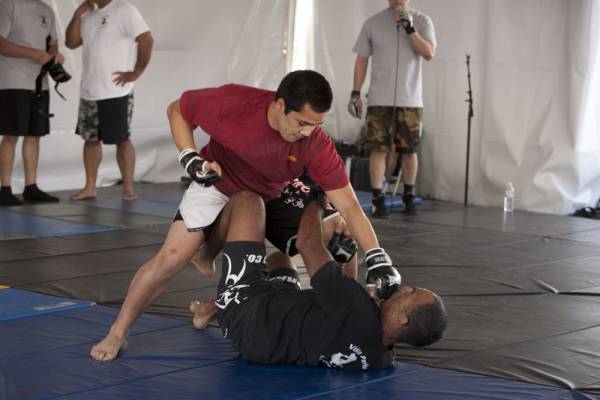Due to some injuries I suffered in 2006 I started looking for ways to train that didn’t hurt me and could offer potential fixes to the damage caused. A combination of handstand push ups, burpees, and letting people kimura me led to some real problems in my AC joint and I wasn’t yet sold on needing shoulder surgery.
At this point I found the kettlebell and the rest became history. One of the things I quickly learned about kettlebells, that I saw immediate uses for with my own clients, was that they “right size” you. If you need to lose some lard then kettlebell ballistics and the near non-stop way you can train with them will help. Likewise, if you’re scrawny and need some muscle they’ll do that, too, without that exaggerated puffed up bodybuilder look.
It was at this point that I got rid of every other type of training I was using with clients and focused solely on kettlebells. Combining kettlebells with a sensible diet and only a few hours of work a week, we get amazing results at Dragon Door Australia when it comes to this lose-fat-tone-up-right-size training.
But sometimes there’s a client we need to actually add some muscle to. Maybe it’s a guy on the edge of his weight class and he needs to add a couple of kilos so he’s no longer the smaller guy on the mat. Maybe he or she is a rugby player and just getting brushed aside going for tackles because of too small size.
It’s always funny to me when I hear people say that certain tools are only good for certain things. I agree when to comes to BOSUs – the only thing they’re good for is as kids’ toys – but when it comes to resistance training you can get the result you need no matter the tool, whether it’s kettlebells, barbells, or dumbbells.
 In the RKC we teach that for pressing you need to keep reps under five to maintain form and limit possible injury. Here’s the thing – sets of five reps are around eighty-five percent of your 1RM. The reason this is important is that once we hit this magic number we are starting to work on the neural adaptations produced from lifting instead of the metabolic changes made possible.
In the RKC we teach that for pressing you need to keep reps under five to maintain form and limit possible injury. Here’s the thing – sets of five reps are around eighty-five percent of your 1RM. The reason this is important is that once we hit this magic number we are starting to work on the neural adaptations produced from lifting instead of the metabolic changes made possible.
What are neural and metabolic adaptations? In simple terms metabolic changes are changes to the muscle cell themselves, such as change in size. Neural adaptation is a way to increase the strength of the message sent through our nervous system to the muscle fibres, essentially telling them to contract harder. So we can make our muscles bigger (metabolic changes) or we can turn up the volume of the message to the muscles (neural changes).
I’m not going to go into how to train for neural adaptations. Pavel has many books out on this and the entire RKC system revolves around it. There’s nothing I can add to make that any better. But for hypertrophy training there are two important things people miss and then scratch their heads and wonder why they aren’t growing:
- Time under tension
- Diet
I’ll do diet first. If you are looking to gain size, you need to eat more than usual. Simple. Figure out your caloric needs based on any of the free BMR calculators on the net and add twenty-five percent.
Time under tension is a bit trickier for many to get their heads around because they simply try to use weights that are too heavy. While it’s true the super-heavyweight lifters do lift the biggest weights, gaining muscle doesn’t actually require you to lift big weights. While a five rep effort is about eighty-five percent of our maximum, for best hypertrophy results we use loads that are more around seventy percent and allow us to get about ten reps.
One of my favourite ways to do this is with kettlebell clean and jerks. Longer sets of these add size quickly to your upper body and I’ve used the approach below to turn some BJJ competitors into absolute mat monsters. I use them like this:
Begin with three rounds of 2-4-6-8-10 reps. After you do each set of clean and jerks do half that number of squats. So, do 2 clean and jerks and immediately do 1 squat. After you rest, proceed and do 4 clean and jerks and then 2 squats. Continue in this fashion until you’ve done 10 clean and jerks and 5 squats.
At this point you’ll probably need a decent rest. Somewhere around three minutes rest should be about right. Then proceed to curse me out until you’ve done all three rounds of 2-4-6-8-10 plus the 1-2-3-4-5 squats.
Here’s how we work it:
- Week 1, Day 1 – start with 3 x 2-4-6-8-10
- Week 1, Day 2 – 3 x 5 clean and jerks with no squats.
- Week 2, Day 1 – 4 x 2-4-6-8-10
- Week 2, Day 2 – 4 x 5 clean and jerks with no squats.
- Week 3, Day 1 – 5 x 2-4-6-8-10
- Week 3, Day 2 – 5 x 5 clean and jerks with no squats.
At this point you start to work on training density – getting more work done following the same programming. You have two variables available to accomplish this: adding weight or decreasing time. Because kettlebells are made with large jumps in sizes your normal option of adding weight won’t necessarily work. Going from, say, double 24kg bells to double 28kg bells is a huge jump in terms of total load. Therefore, the option of reducing the time you train is very useful.
 During all this training the muscles of the upper body are working extremely hard to move and stabilize the kettlebells through the cleans, jerks, and squats giving you massive time under tension. In addition because the jerk is such a useful power exercise you’re also increasing speed for takedown attempts and sprawling.
During all this training the muscles of the upper body are working extremely hard to move and stabilize the kettlebells through the cleans, jerks, and squats giving you massive time under tension. In addition because the jerk is such a useful power exercise you’re also increasing speed for takedown attempts and sprawling.
For the grapplers we used this program with, most added around five kilograms of bodyweight in six months. The added benefit of the incidental conditioning and grip work from the kettlebell training meant we didn’t need much special conditioning work prior to big events and spent only an hour a week for five weeks on conditioning in the final build up.
Give it a try for a few months and see. Let me know how much muscle you put on.






